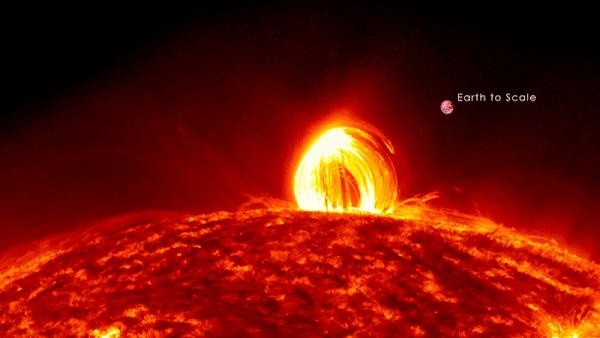Solar flares are reappearing again. Experts say, a new solar storm may happen on May 26. Is that because of the new sunspots that have formed in the solar system's most giant star?
A massive solar storm exploded on the sun's atmosphere earlier this month, as Science Times reported. The phenomenon blasted millions of tons of super-heated gas off the moon in the direction of Earth. This kind of explosion is known as a coronal mass ejection, and it wasn't especially effective on a galactic scale.

Powerful Solar Flares Bursts
According to Express, experts noted a newly-emerged sunspot released a "flurry" of solar flares on May 22. It resulted in particles being fired into the solar system. The bursts were fairly powerful, with some being classified as 'M-class.'
Solar flares of the M-class have the potential to trigger radio blackouts on Earth. Solar flares can be harmful to radio waves and when they enter the atmosphere, they cause ionization, which depletes the energy of radio waves.
Other solar flares have been classified as 'C-class.' While these solar flares are small, they can still cause auroras. Auroras, such as the northern lights (aurora borealis) and the southern lights (aurora australis), are caused when solar particles collide with the Earth's atmosphere.
If the magnetosphere is bombarded by solar winds, dazzling blue lights will emerge as the electrons are deflected by that layer of the atmosphere. Experts aren't sure if the flares will reach Earth directly, but they'll most likely glance off the globe on May 26.
"Yesterday, May 22, sunspot AR2824 unleashed a flurry of solar flares, unlike anything we've seen in years," astronomer Dr. Tony Phillips of Space Weather wrote on Space Weather.
"NASA's Solar Dynamics Observatory recorded 9 C-class flares and 2 M-class flares in only 24 hours," Dr. Phillips added.
Many overlapping CMEs were launched into space, according to him, as a result of the rapid fire blasts. Dr. Phillips said NOAA researchers are still "untangling the clouds" to see if any could reach Earth. Researchers point out, though, that the effects of a solar storm and space weather can be felt far outside the northern and southern lights.
Experts Explain How 'Harmful' Solar Storms Are
Bloomberg said it doesn't take a powerful solar storm to have an effect on Earth. In years, the largest geomagnetic storm was caused when debris expelled from the sun's surface collided with the magnetic field covering the planet. Most people were possibly unaware of the solar storm because it was not especially strong.
However, the storm's importance is that it signaled the beginning of an era of increased activity for the sun, which had been largely dormant for many years. Solar storm geomagnetic waves will damage power grids, jam radio signals, expose flight crews to harmful radiation levels, and disrupt vital satellites.
The sun goes through 11-year periods, and the next period of intensified development began in 2020. In 2025, the loop will hit its apex, with the prospect of severe space weather creating problems on Earth. Surprisingly, SlashGear recently claimed that hardening the electric grid in the United States could save the US power sector $27 billion.
The effects of solar weather on life on Earth are huge. Scientists point to a solar storm in 2017 that triggered ham radios to become static-filled just as Hurricane Irma was making landfall in the Caribbean. In 2015, a solar storm in the Northeastern United States wiped down GPS networks.
The Carrington Event, the most powerful solar storm ever seen, occurred in 1859, when telegraph lines were electrified, shocking operators and causing fires in offices throughout North America and Europe. Today, a storm of that size could knock out electricity to millions or billions of people.
Check out more news and information on Space on Science Times.
© 2025 ScienceTimes.com All rights reserved. Do not reproduce without permission. The window to the world of Science Times.












